High-Tyrosol/Hydroxytyrosol Extra Virgin Olive Oil Enhances Antioxidant Activity in Elderly Post-Myocardial Infarction Patients
Abstract
1. Introduction
2. Materials and Methods
2.1. Study Design and Subjects
2.2. Olive Oils
2.3. Blood Collection
2.4. Biochemical Analyses
2.4.1. Plasma Total (Poly)phenols Measurement
2.4.2. Ferric Reducing Antioxidant Power (FRAP)
2.4.3. PON-1 Activity Measurement
2.4.4. MDA Measurement
2.4.5. LCAT Activity Measurement
2.5. Statistical Analysis
3. Results
3.1. Participants’ Characteristics
3.2. Biochemical Outcomes
4. Discussion
5. Conclusions
Author Contributions
Funding
Institutional Review Board Statement
Informed Consent Statement
Data Availability Statement
Conflicts of Interest
Abbreviations
| ASCVD | Atherosclerotic cardiovascular disease |
| BMI | Body mass index |
| BP | Blood pressure |
| CRP | C-reactive protein |
| CVD | Cardiovascular disease |
| EFSA | European Food Safety Authority |
| EVOO | Extra virgin olive oil |
| FRAP | Ferric reducing antioxidant power |
| HDL | High-density lipoprotein |
| HO-1 | Heme oxygenase-1 |
| HP-EVOO | High-phenolic (HTyr/Tyr) extra virgin olive oil |
| HTyr | Hydroxytyrosol |
| IHD | Ischemic heart disease |
| LCAT | Lecithin-cholesterol acyltransferase |
| LDL | Low-density lipoprotein |
| Lipoprotein (a) | Lp (a) |
| LPS | Lipopolysaccharide |
| MD | Mediterranean diet |
| MDA | Malondialdehyde |
| MUFA | Monounsaturated fats |
| NO | Nitric oxide |
| Nrf2 | Nuclear factor erythroid 2-related factor 2 |
| ox-LDL | Oxidized low-density lipoprotein |
| PON-1 | Paraoxonase-1 |
| Post-MI | Post-myocardial infarction |
| ROO | Refined olive oil |
| ROS | Reactive oxygen species |
| SE | Standard error |
| SOD-1 | Superoxide dismutase-1 |
| TAC | Total antioxidant status |
| TC | Total cholesterol |
| TG | Triglyceride |
| Tyr | Tyrosol |
References
- Nedkoff, L.; Briffa, T.; Zemedikun, D.; Herrington, S.; Wright, F.L. Global Trends in Atherosclerotic Cardiovascular Disease. Clin. Ther. 2023, 45, 1087–1091. [Google Scholar] [CrossRef]
- Wolf, D.; Ley, K. Immunity and Inflammation in Atherosclerosis. Circ. Res. 2019, 124, 315–327. [Google Scholar] [CrossRef]
- Libby, P.; Buring, J.E.; Badimon, L.; Hansson, G.K.; Deanfield, J.; Bittencourt, M.S.; Tokgözoğlu, L.; Lewis, E.F. Atherosclerosis. Nat. Rev. Dis. Primer 2019, 5, 56. [Google Scholar] [CrossRef] [PubMed]
- Kariuki, J.K.; Imes, C.C.; Engberg, S.J.; Scott, P.W.; Klem, M.L.; Cortes, Y.I. Impact of lifestyle-based interventions on absolute cardiovascular disease risk: A systematic review and meta-analysis. JBI Evid. Synth. 2024, 22, 4–65. [Google Scholar] [CrossRef] [PubMed]
- Zhang, W.; Zheng, Y.; Yan, F.; Dong, M.; Ren, Y. Research progress of quercetin in cardiovascular disease. Front. Cardiovasc. Med. 2023, 10, 1203713. [Google Scholar] [CrossRef]
- Bonaccio, M.; Di Castelnuovo, A.; Costanzo, S.; Persichillo, M.; De Curtis, A.; Cerletti, C.; Donati, M.B.; de Gaetano, G.; Iacoviello, L. Interaction between Mediterranean diet and statins on mortality risk in patients with cardiovascular disease: Findings from the Moli-sani Study. Int. J. Cardiol. 2019, 276, 248–254. [Google Scholar] [CrossRef]
- Guasch-Ferré, M.; Hu, F.B.; Martínez-González, M.A.; Fitó, M.; Bulló, M.; Estruch, R.; Ros, E.; Corella, D.; Recondo, J.; Gómez-Gracia, E.; et al. Olive oil intake and risk of cardiovascular disease and mortality in the PREDIMED Study. BMC Med. 2014, 12, 78. [Google Scholar] [CrossRef]
- Guo, X.; Tresserra-Rimbau, A.; Estruch, R.; Martínez-González, M.A.; Medina-Remón, A.; Castañer, O.; Corella, D.; Salas-Salvadó, J.; Lamuela-Raventós, R.M. Effects of Polyphenol, Measured by a Biomarker of Total Polyphenols in Urine, on Cardiovascular Risk Factors After a Long-Term Follow-Up in the PREDIMED Study. Oxid. Med. Cell. Longev. 2016, 2016, 2572606. [Google Scholar] [CrossRef]
- Covas, M.-I.; Nyyssönen, K.; Poulsen, H.E.; Kaikkonen, J.; Zunft, H.-J.F.; Kiesewetter, H.; Gaddi, A.; de la Torre, R.; Mursu, J.; Bäumler, H.; et al. The effect of polyphenols in olive oil on heart disease risk factors: A randomized trial. Ann. Intern. Med. 2006, 145, 333–341. [Google Scholar] [CrossRef]
- Perrone, M.A.; Gualtieri, P.; Gratteri, S.; Ali, W.; Sergi, D.; Muscoli, S.; Cammarano, A.; Bernardini, S.; Di Renzo, L.; Romeo, F. Effects of postprandial hydroxytyrosol and derivates on oxidation of LDL, cardiometabolic state and gene expression: A nutrigenomic approach for cardiovascular prevention. J. Cardiovasc. Med. 2019, 20, 419–426. [Google Scholar] [CrossRef]
- Boronat, A.; Mateus, J.; Soldevila-Domenech, N.; Guerra, M.; Rodríguez-Morató, J.; Varon, C.; Muñoz, D.; Barbosa, F.; Morales, J.C.; Gaedigk, A.; et al. Cardiovascular benefits of tyrosol and its endogenous conversion into hydroxytyrosol in humans. A randomized, controlled trial. Free Radic. Biol. Med. 2019, 143, 471–481. [Google Scholar] [CrossRef]
- EFSA Panel on Dietetic Products N and A (NDA). Scientific opinion on the substantiation of health claims related to polyphenols in olive and protection of LDL particles from oxidative damage (ID 1333, 1638, 1639, 1696, 2865), maintenance of normal blood HDL cholesterol concentrations (ID 1639), maintenance of normal blood pressure (ID 3781),”anti-inflammatory properties”(ID 1882),”contributes to the upper respiratory tract health”(ID 3468),”can help to maintain a normal function of gastrointestinal tract”(3779), and “contributes to body defences against external agents”(ID 3467) pursuant to Article 13 (1) of Regulation (EC) No 1924/2006. EFSA J. 2011, 9, 2033. [Google Scholar]
- Mancebo-Campos, V.; Salvador, M.D.; Fregapane, G. EFSA Health Claims-Based Virgin Olive Oil Shelf-Life. Antioxidants 2023, 12, 1563. [Google Scholar] [CrossRef] [PubMed]
- Visioli, F.; Poli, A.; Gall, C. Antioxidant and other biological activities of phenols from olives and olive oil. Med. Res. Rev. 2002, 22, 65–75. [Google Scholar] [CrossRef] [PubMed]
- De la Torre-Carbot, K.; Jauregui, O.; Gimeno, E.; Castellote, A.I.; Lamuela-Raventós, R.M.; López-Sabater, M.C. Characterization and quantification of phenolic compounds in olive oils by solid-phase extraction, HPLC-DAD, and HPLC-MS/MS. J. Agric. Food Chem. 2005, 53, 4331–4340. [Google Scholar] [CrossRef]
- Fitó, M.; Cladellas, M.; De La Torre, R.; Marti, J.; Alcántara, M.; Pujadas-Bastardes, M.; Marrugat, J.; Bruguera, J.; López-Sabater, M.C.; Vila, J.; et al. Antioxidant effect of virgin olive oil in patients with stable coronary heart disease: A randomized, crossover, controlled, clinical trial. Atherosclerosis 2005, 181, 149–158. [Google Scholar] [CrossRef]
- Zrelli, H.; Kusunoki, M.; Miyazaki, H. Role of hydroxytyrosol-dependent regulation of HO-1 expression in promoting wound healing of vascular endothelial cells via Nrf2 de novo synthesis and stabilization. Phytother. Res. 2015, 29, 1011–1018. [Google Scholar] [CrossRef]
- Wang, W.; Xia, Y.; Yang, B.; Su, X.; Chen, J.; Li, W.; Jiang, T. Protective Effects of Tyrosol against LPS-Induced Acute Lung Injury via Inhibiting NF-κB and AP-1 Activation and Activating the HO-1/Nrf2 Pathways. Biol. Pharm. Bull. 2017, 40, 583–593. [Google Scholar] [CrossRef]
- Vijakumaran, U.; Shanmugam, J.; Heng, J.W.; Azman, S.S.; Yazid, M.D.; Haizum Abdullah, N.A.; Sulaiman, N. Effects of Hydroxytyrosol in Endothelial Functioning: A Comprehensive Review. Molecules 2023, 28, 1861. [Google Scholar] [CrossRef]
- Karković Marković, A.; Torić, J.; Barbarić, M.; Jakobušić Brala, C. Hydroxytyrosol, Tyrosol and Derivatives and Their Potential Effects on Human Health. Molecules 2019, 24, 2001. [Google Scholar] [CrossRef]
- Hohmann, C.D.; Cramer, H.; Michalsen, A.; Kessler, C.; Steckhan, N.; Choi, K.; Dobos, G. Effects of high phenolic olive oil on cardiovascular risk factors: A systematic review and meta-analysis. Phytomedicine 2015, 22, 631–640. [Google Scholar] [CrossRef]
- George, E.S.; Marshall, S.; Mayr, H.L.; Trakman, G.L.; Tatucu-Babet, O.A.; Lassemillante, A.-C.M.; Bramley, A.; Reddy, A.J.; Forsyth, A.; Tierney, A.C.; et al. The effect of high-polyphenol extra virgin olive oil on cardiovascular risk factors: A systematic review and meta-analysis. Crit. Rev. Food Sci. Nutr. 2019, 59, 2772–2795. [Google Scholar] [CrossRef] [PubMed]
- Morvaridzadeh, M.; Cohen, A.A.; Heshmati, J.; Alami, M.; Berrougui, H.; Zoubdane, N.; Pizarro, A.B.; Khalil, A. Effect of Extra Virgin Olive Oil on Anthropometric Indices, Inflammatory and Cardiometabolic Markers: A Systematic Review and Meta-Analysis of Randomized Clinical Trials. J. Nutr. 2024, 154, 95–120. [Google Scholar] [CrossRef] [PubMed]
- Feingold, K.R.; Grunfeld, C. Effect of inflammation on HDL structure and function. Curr. Opin. Lipidol. 2016, 27, 521–530. Available online: https://journals.lww.com/co-lipidology/fulltext/2016/10000/effect_of_inflammation_on_hdl_structure_and.12.aspx (accessed on 10 July 2025). [CrossRef] [PubMed]
- Oprescu, N.; Micheu, M.M.; Scafa-Udriste, A.; Popa-Fotea, N.-M.; Dorobantu, M. Inflammatory markers in acute myocardial infarction and the correlation with the severity of coronary heart disease. Ann. Med. 2021, 53, 1041–1047. [Google Scholar] [CrossRef]
- Djekic, S.; Vekic, J.; Zeljkovic, A.; Kotur-Stevuljevic, J.; Kafedzic, S.; Zdravkovic, M.; Ilic, I.; Hinic, S.; Cerovic, M.; Stefanovic, M.; et al. HDL Subclasses and the Distribution of Paraoxonase-1 Activity in Patients with ST-Segment Elevation Acute Myocardial Infarction. Int. J. Mol. Sci. 2023, 24, 9384. [Google Scholar] [CrossRef]
- Annema, W.; Willemsen, H.M.; de Boer, J.F.; Dikkers, A.; van der Giet, M.; Nieuwland, W.; Kobold, A.C.M.; van Pelt, L.J.; Slart, R.H.; van der Horst, I.C. HDL function is impaired in acute myocardial infarction independent of plasma HDL cholesterol levels. J. Clin. Lipidol. 2016, 10, 1318–1328. [Google Scholar] [CrossRef]
- Li, S.; Peng, Y.; Wang, X.; Qian, Y.; Xiang, P.; Wade, S.W.; Guo, H.; Lopez, J.A.G.; Herzog, C.A.; Handelsman, Y. Cardiovascular events and death after myocardial infarction or ischemic stroke in an older Medicare population. Clin. Cardiol. 2019, 42, 391–399. [Google Scholar] [CrossRef]
- Farràs, M.; Fernández-Castillejo, S.; Rubió, L.; Arranz, S.; Catalán, Ú.; Subirana, I.; Romero, M.-P.; Castañer, O.; Pedret, A.; Blanchart, G.; et al. Phenol-enriched olive oils improve HDL antioxidant content in hypercholesterolemic subjects. A randomized, double-blind, cross-over, controlled trial. J. Nutr. Biochem. 2018, 51, 99–104. [Google Scholar] [CrossRef]
- Serafini, M.; Maiani, G.; Ferro-Luzzi, A. Alcohol-free red wine enhances plasma antioxidant capacity in humans. J. Nutr. 1998, 128, 1003–1007. [Google Scholar] [CrossRef]
- Seres, I.; Paragh, G.; Deschene, E.; Fulop, T.J.; Khalil, A. Study of factors influencing the decreased HDL associated PON1 activity with aging. Exp. Gerontol. 2004, 39, 59–66. [Google Scholar] [CrossRef] [PubMed]
- Nezami, N.; Ghorbanihaghjo, A.; Rashtchizadeh, N.; Argani, H.; Tafrishinejad, A.; Ghorashi, S.; Hajhosseini, B. Atherogenic changes of low-density lipoprotein susceptibility to oxidation, and antioxidant enzymes in pulmonary tuberculosis. Atherosclerosis 2011, 217, 268–273. [Google Scholar] [CrossRef] [PubMed]
- Yagi, K. A simple fluorometric assay for lipoperoxide in blood plasma. Biochem. Med. 1976, 15, 212–216. [Google Scholar] [CrossRef] [PubMed]
- Bender, C.; Strassmann, S.; Golz, C. Oral Bioavailability and Metabolism of Hydroxytyrosol from Food Supplements. Nutrients 2023, 15, 325. [Google Scholar] [CrossRef]
- Pastor, A.; Rodríguez-Morató, J.; Olesti, E.; Pujadas, M.; Pérez-Mañá, C.; Khymenets, O.; Fitó, M.; Covas, M.-I.; Solá, R.; Motilva, M.-J.; et al. Analysis of free hydroxytyrosol in human plasma following the administration of olive oil. J. Chromatogr. A 2016, 1437, 183–190. [Google Scholar] [CrossRef]
- Alemán-Jiménez, C.; Domínguez-Perles, R.; Medina, S.; Prgomet, I.; López-González, I.; Simonelli-Muñoz, A.; Campillo-Cano, M.; Auñón, D.; Ferreres, F.; Gil-Izquierdo, Á. Pharmacokinetics and bioavailability of hydroxytyrosol are dependent on the food matrix in humans. Eur. J. Nutr. 2021, 60, 905–915. [Google Scholar] [CrossRef]
- de Bock, M.; Thorstensen, E.B.; Derraik, J.G.B.; Henderson, H.V.; Hofman, P.L.; Cutfield, W.S. Human absorption and metabolism of oleuropein and hydroxytyrosol ingested as olive (Olea europaea L.) leaf extract. Mol. Nutr. Food Res. 2013, 57, 2079–2085. [Google Scholar] [CrossRef]
- Wood, E.; Hein, S.; Mesnage, R.; Fernandes, F.; Abhayaratne, N.; Xu, Y.; Zhang, Z.; Bell, L.; Williams, C.; Rodriguez-Mateos, A. Wild blueberry (poly)phenols can improve vascular function and cognitive performance in healthy older individuals: A double-blind randomized controlled trial. Am. J. Clin. Nutr. 2023, 117, 1306–1319. [Google Scholar] [CrossRef]
- Ruiz-García, I.; Ortíz-Flores, R.; Badía, R.; García-Borrego, A.; García-Fernández, M.; Lara, E.; Martín-Montañez, E.; García-Serrano, S.; Valdés, S.; Gonzalo, M.; et al. Rich oleocanthal and oleacein extra virgin olive oil and inflammatory and antioxidant status in people with obesity and prediabetes. The APRIL study: A randomised, controlled crossover study. Clin. Nutr. Edinb. Scotl. 2023, 42, 1389–1398. [Google Scholar] [CrossRef]
- Poznyak, A.V.; Nikiforov, N.G.; Markin, A.M.; Kashirskikh, D.A.; Myasoedova, V.A.; Gerasimova, E.V.; Orekhov, A.N. Overview of OxLDL and its impact on cardiovascular health: Focus on atherosclerosis. Front. Pharmacol. 2021, 11, 613780. [Google Scholar] [CrossRef]
- Jiang, H.; Zhou, Y.; Nabavi, S.M.; Sahebkar, A.; Little, P.J.; Xu, S.; Weng, J.; Ge, J. Mechanisms of oxidized LDL-mediated endothelial dysfunction and its consequences for the development of atherosclerosis. Front. Cardiovasc. Med. 2022, 9, 925923. [Google Scholar] [CrossRef]
- Tsutsui, T.; Tsutamoto, T.; Wada, A.; Maeda, K.; Mabuchi, N.; Hayashi, M.; Ohnishi, M.; Kinoshita, M. Plasma oxidized low-density lipoprotein as a prognostic predictor in patients with chronic congestive heart failure. J. Am. Coll. Cardiol. 2002, 39, 957–962. [Google Scholar] [CrossRef] [PubMed]
- Lopez-Huertas, E.; Fonolla, J. Hydroxytyrosol supplementation increases vitamin C levels in vivo. A human volunteer trial. Redox Biol. 2017, 11, 384–389. [Google Scholar] [CrossRef] [PubMed]
- Jemai, H.; Fki, I.; Bouaziz, M.; Bouallagui, Z.; El Feki, A.; Isoda, H.; Sayadi, S. Lipid-Lowering and Antioxidant Effects of Hydroxytyrosol and Its Triacetylated Derivative Recovered from Olive Tree Leaves in Cholesterol-Fed Rats. J. Agric. Food Chem. 2008, 56, 2630–2636. [Google Scholar] [CrossRef] [PubMed]
- Calabriso, N.; Gnoni, A.; Stanca, E.; Cavallo, A.; Damiano, F.; Siculella, L.; Carluccio, M.A. Hydroxytyrosol ameliorates endothelial function under inflammatory conditions by preventing mitochondrial dysfunction. Oxid. Med. Cell. Longev. 2018, 2018, 9086947. [Google Scholar] [CrossRef]
- Ikonomidis, I.; Katogiannis, K.; Chania, C.; Iakovis, N.; Tsoumani, M.; Christodoulou, A.; Brinia, E.; Pavlidis, G.; Thymis, J.; Tsilivarakis, D.; et al. Association of hydroxytyrosol enriched olive oil with vascular function in chronic coronary disease. Eur. J. Clin. Investig. 2023, 53, e13983. [Google Scholar] [CrossRef]
- Colica, C.; Di Renzo, L.; Trombetta, D.; Smeriglio, A.; Bernardini, S.; Cioccoloni, G.; Costa de Miranda, R.; Gualtieri, P.; Sinibaldi Salimei, P.; De Lorenzo, A. Antioxidant Effects of a Hydroxytyrosol-Based Pharmaceutical Formulation on Body Composition, Metabolic State, and Gene Expression: A Randomized Double-Blinded, Placebo-Controlled Crossover Trial. Oxid. Med. Cell. Longev. 2017, 2017, 2473495. [Google Scholar] [CrossRef]
- Vissers, M.; Zock, P.; Wiseman, S.; Meyboom, S.; Katan, M. Effect of phenol-rich extra virgin olive oil on markers of oxidation in healthy volunteers. Eur. J. Clin. Nutr. 2001, 55, 334–341. [Google Scholar] [CrossRef]
- Quirós-Fernández, R.; López-Plaza, B.; Bermejo, L.M.; Palma-Milla, S.; Gómez-Candela, C. Supplementation with Hydroxytyrosol and Punicalagin Improves Early Atherosclerosis Markers Involved in the Asymptomatic Phase of Atherosclerosis in the Adult Population: A Randomized, Placebo-Controlled, Crossover Trial. Nutrients 2019, 11, 640. [Google Scholar] [CrossRef]
- Sirca, T.B.; Mureșan, M.E.; Pallag, A.; Marian, E.; Jurca, T.; Vicaș, L.G.; Tunduc, I.P.; Manole, F.; Ștefan, L. The Role of Polyphenols in Modulating PON1 Activity Regarding Endothelial Dysfunction and Atherosclerosis. Int. J. Mol. Sci. 2024, 25, 2962. [Google Scholar] [CrossRef]
- Mahrooz, A. Chapter Three—Pleiotropic functions and clinical importance of circulating HDL-PON1 complex. In Advances in Clinical Chemistry; Makowski, G.S., Ed.; Elsevier: Amsterdam, The Netherlands, 2024; pp. 132–171. Available online: https://www.sciencedirect.com/science/article/pii/S0065242324000647 (accessed on 10 July 2025).
- Kumar, M.; Ali, W.; Yadav, K.; Kaumri, S.; Mishra, S.; Nardi, P.; Iellamo, F.; Bernardini, S.; Pradhan, A.; Perrone, M.A. High-Density Lipoprotein-Associated Paraoxonase-1 (PON-1) and Scavenger Receptor Class B Type 1 (SRB-1) in Coronary Artery Disease: Correlation with Disease Severity. J. Clin. Med. 2024, 13, 5480. [Google Scholar] [CrossRef]
- Durrington, P.N.; Bashir, B.; Soran, H. Paraoxonase 1 and atherosclerosis. Front. Cardiovasc. Med. 2023, 10, 1065967. [Google Scholar] [CrossRef]
- Manning, P.J.; de Jong, S.A.; Ryalls, A.R.; Sutherland, W.H.F. Paraoxonase 1 activity in chylomicrons and VLDL: The effect of type 2 diabetes and meals rich in saturated fat and oleic acid. Lipids 2012, 47, 259–267. [Google Scholar] [CrossRef]
- Boshtam, M.; Razavi, A.E.; Pourfarzam, M.; Ani, M.; Naderi, G.A.; Basati, G.; Mansourian, M.; Dinani, N.J.; Asgary, S.; Abdi, S. Serum paraoxonase 1 activity is associated with fatty acid composition of high density lipoprotein. Dis. Markers 2013, 35, 273–280. [Google Scholar] [CrossRef] [PubMed]
- Farràs, M.; Castañer, O.; Martín-Peláez, S.; Hernáez, Á.; Schröder, H.; Subirana, I.; Muñoz-Aguayo, D.; Gaixas, S.; de la Torre, R.; Farré, M.; et al. Complementary phenol-enriched olive oil improves HDL characteristics in hypercholesterolemic subjects. A randomized, double-blind, crossover, controlled trial. The VOHF study. Mol. Nutr. Food Res. 2015, 59, 1758–1770. [Google Scholar] [CrossRef] [PubMed]
- Oldoni, F.; Baldassarre, D.; Castelnuovo, S.; Ossoli, A.; Amato, M.; van Capelleveen, J.; Hovingh, G.K.; De Groot, E.; Bochem, A.; Simonelli, S. Complete and partial lecithin: Cholesterol acyltransferase deficiency is differentially associated with atherosclerosis. Circulation 2018, 138, 1000–1007. [Google Scholar] [CrossRef] [PubMed]
- Kunnen, S.; Van Eck, M. Lecithin: Cholesterol acyltransferase: Old friend or foe in atherosclerosis? J. Lipid Res. 2012, 53, 1783–1799. [Google Scholar] [CrossRef]
- Ossoli, A.; Pavanello, C.; Calabresi, L. High-Density Lipoprotein, Lecithin: Cholesterol Acyltransferase, and Atherosclerosis. Endocrinol Metab 2016, 31, 223–229. [Google Scholar] [CrossRef]
- Tanigawa, H.; Billheimer, J.T.; Tohyama, J.; Fuki, I.V.; Ng, D.S.; Rothblat, G.H.; Rader, D.J. Lecithin: Cholesterol acyltransferase expression has minimal effects on macrophage reverse cholesterol transport in vivo. Circulation 2009, 120, 160–169. [Google Scholar] [CrossRef]
- Calabresi, L.; Baldassarre, D.; Simonelli, S.; Gomaraschi, M.; Amato, M.; Castelnuovo, S.; Frigerio, B.; Ravani, A.; Sansaro, D.; Kauhanen, J.; et al. Plasma lecithin: Cholesterol acyltransferase and carotid intima-media thickness in European individuals at high cardiovascular risk. J. Lipid Res. 2011, 52, 1569–1574. [Google Scholar] [CrossRef]
- Stadler, J.T.; Bärnthaler, T.; Borenich, A.; Emrich, I.E.; Habisch, H.; Rani, A.; Holzer, M.; Madl, T.; Heine, G.H.; Marsche, G. Low LCAT activity is linked to acute decompensated heart failure and mortality in patients with CKD. J. Lipid Res. 2024, 65, 100624. [Google Scholar] [CrossRef]
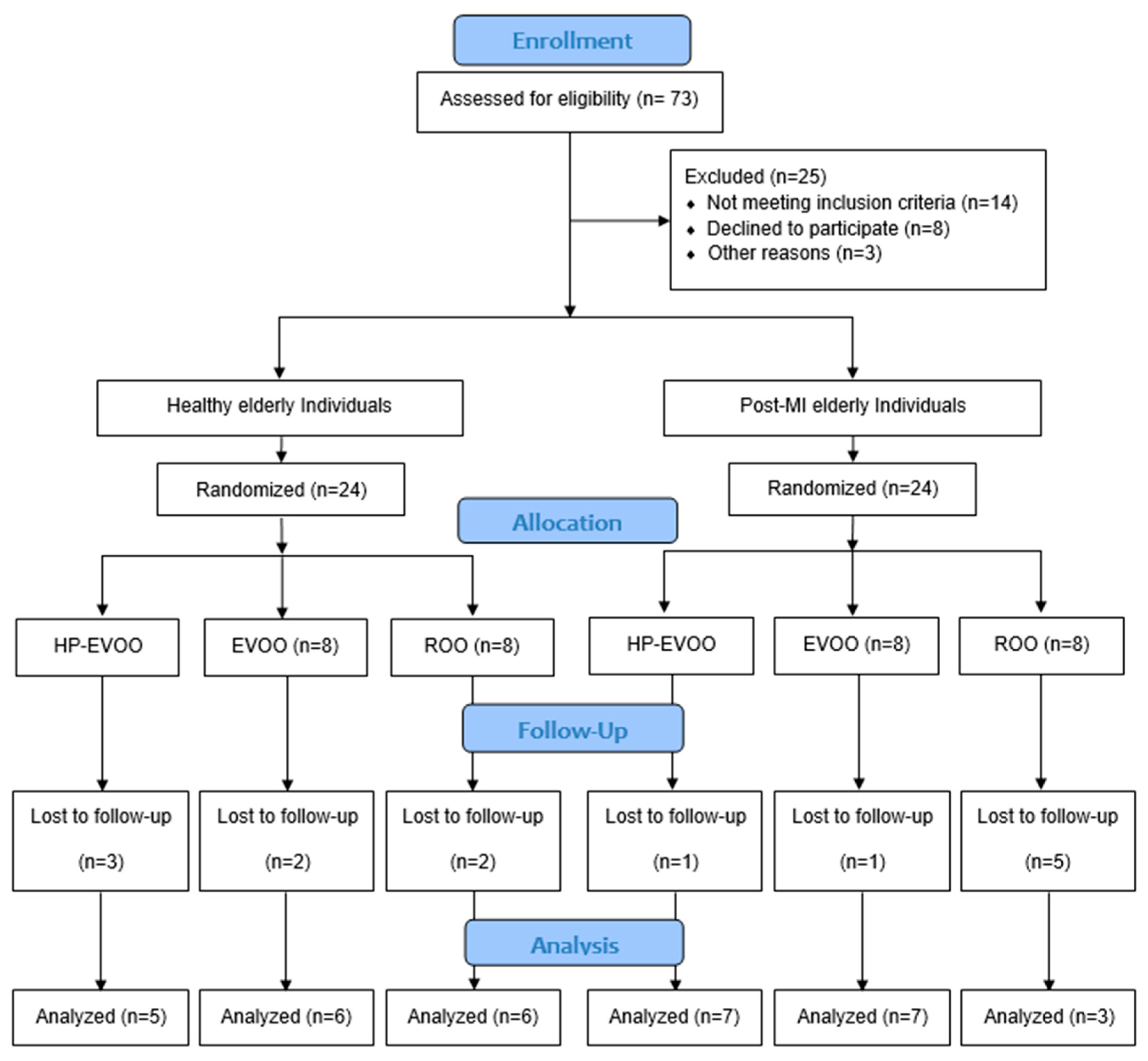
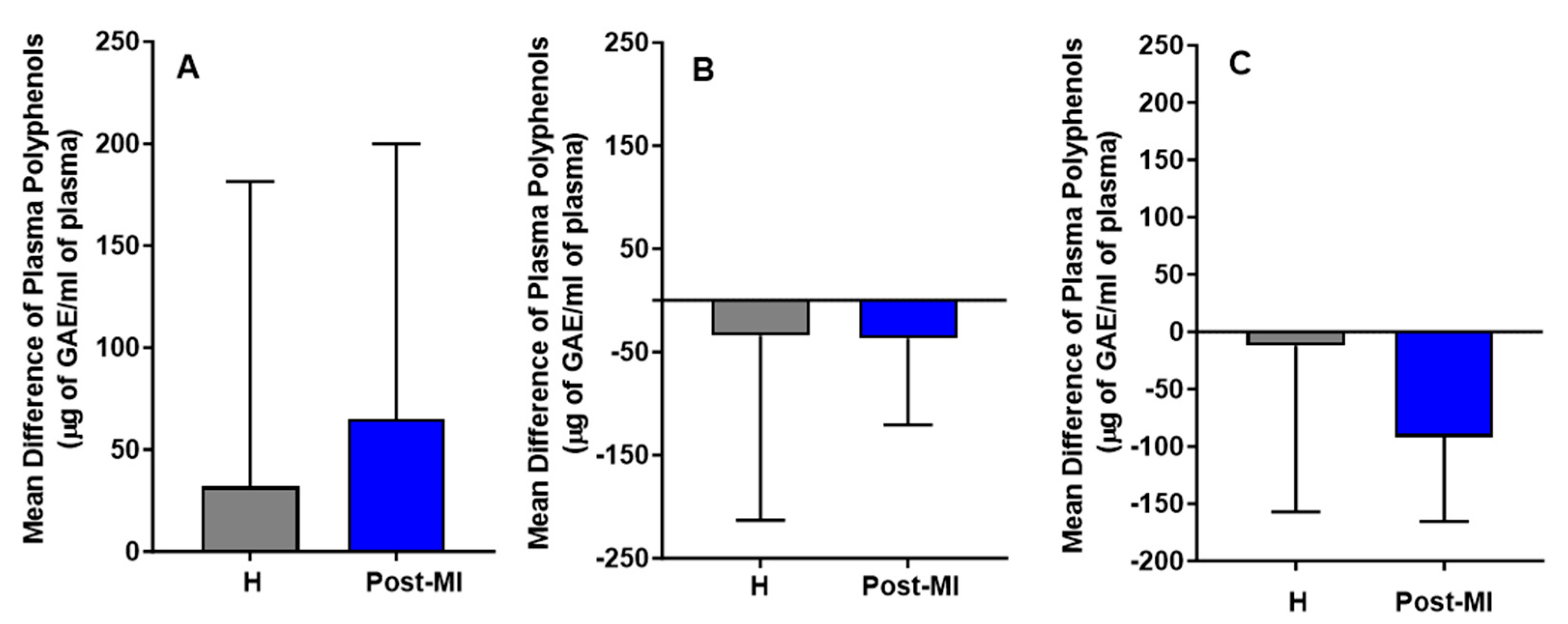

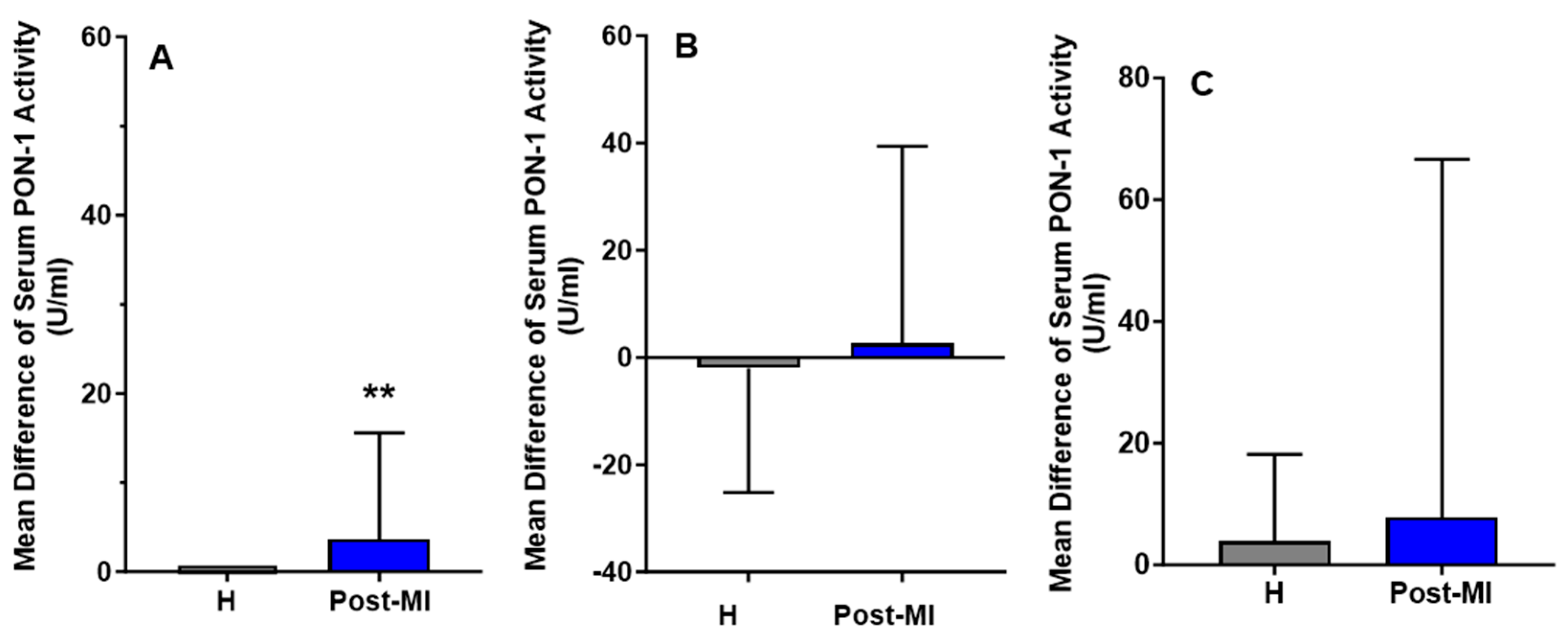
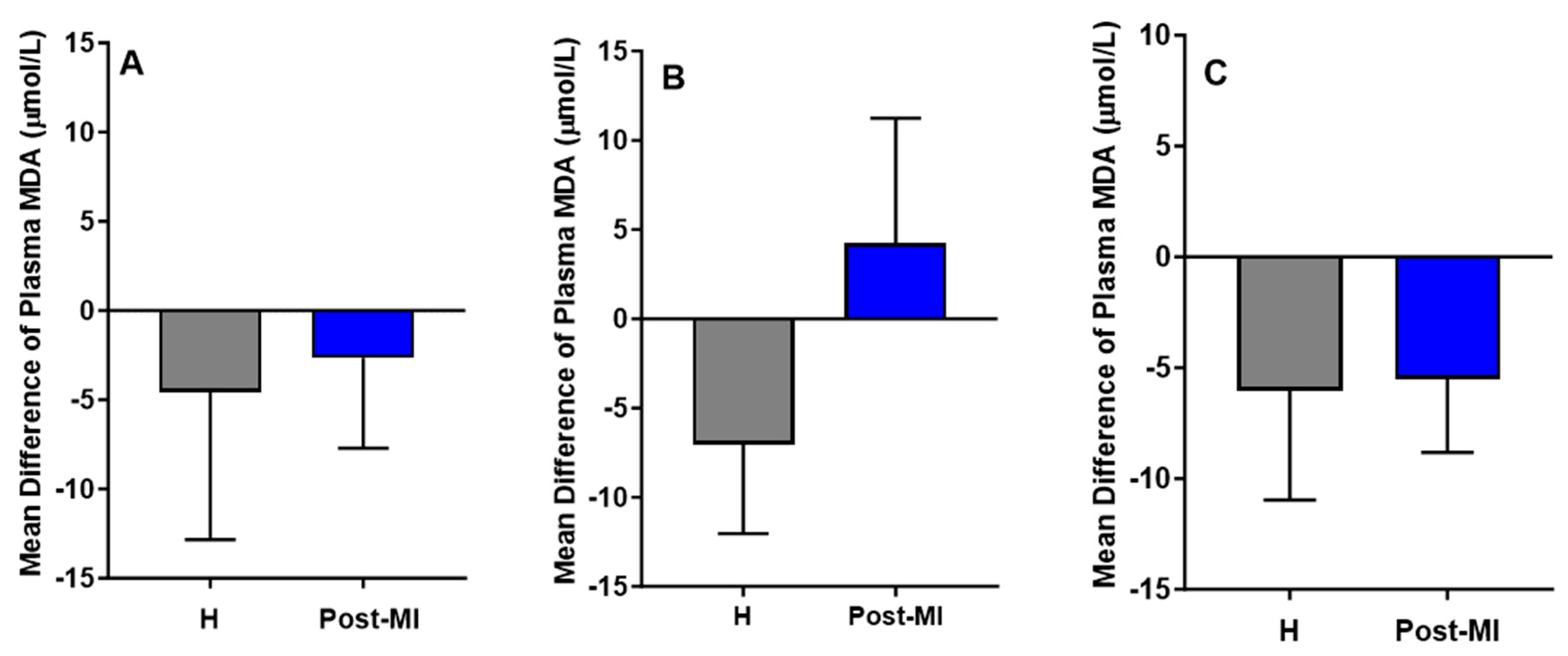
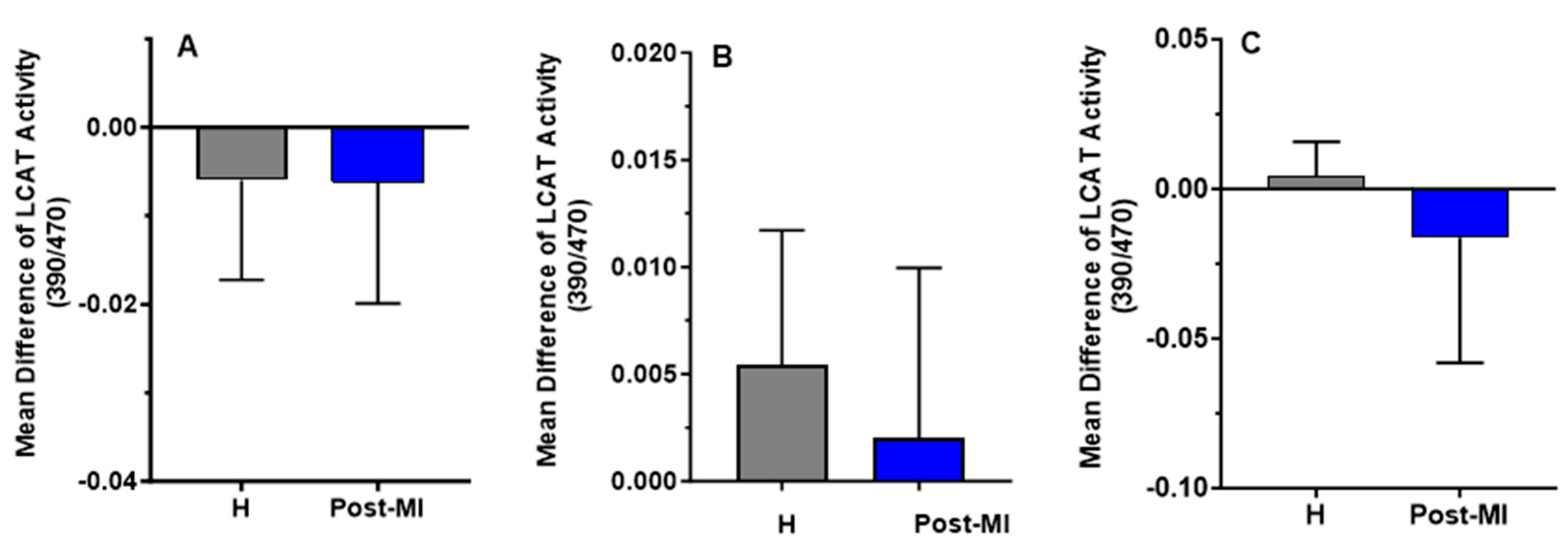
| HP-EVOO | EVOO | ROO | ||||||||
|---|---|---|---|---|---|---|---|---|---|---|
| Healthy | Post-MI | p-Value (Between Groups) | Healthy | Post-MI | p-Value (Between Groups) | Healthy | Post-MI | p-Value (Between Groups) | ||
| Sex | Women | 1 | 1 | 3 | 2 | 4 | 1 | |||
| Men | 4 | 6 | 3 | 5 | 2 | 2 | ||||
| Age | 71 ± 2.34 | 75.71 ± 2.97 | 0.272 | 76.67 ± 1.82 | 71.5 ± 2.19 | 0.124 | 76 ± 2.87 | 73.67 ± 2.33 | 0.618 | |
| Weight (kg) | Before | 94 ± 15.70 | 79.79 ± 4.66 | 0.339 | 68.85 ± 7.37 | 73.13 ± 3.15 | 0.584 | 78.78 ± 5.34 | 81.73 ± 14.09 | 0.814 |
| After | 95.62 ± 16.82 | 80.58 ± 4.98 | 0.376 | 69.32 ± 6.90 | 75.96 ± 2.98 | 0.433 | 81.83 ± 4.10 | 82.83 ± 13.06 | 0.714 | |
| p-value (Within groups) | 0.300 | 0.062 | 0.473 | 0.909 | 0.156 | 0.641 | ||||
| BMI (kg/m2) | Before | 31.51 ± 4.85 | 26.58 ± 1.06 | 0.431 | 25.70 ± 2.00 | 27.15 ± 1.08 | 0.521 | 28.47 ± 1.86 | 28.33 ± 2.75 | 0.969 |
| After | 32.05 ± 5.20 | 27.08 ± 1.19 | 0.536 | 25.93 ± 1.88 | 28.09 ± 1.274 | 0.536 | 29.61 ± 1.60 | 28.97 ± 2.48 | 0.828 | |
| p-value (Within groups) | 0.307 | 0.062 | 0.385 | 0.812 | 0.184 | 0.318 | ||||
| Systolic BP (mmHg) | Before | 143.4 ± 6.76 | 147.0 ± 9.27 | 0.778 | 136.4 ± 6.50 | 131.1 ± 2.50 | 0.413 | 146.0 ± 9.55 | 132.0 ± 1.52 | 0.351 |
| After | 144.4 ± 5.51 | 126.0 ± 9.15 | 0.137 | 124.3 ± 11.83 | 137.0 ± 7.50 | 0.412 | 141.8 ± 12.38 | 136.3 ± 12.12 | 0.789 | |
| p-value (Within groups) | 0.731 | 0.051 | 0.366 | 0.589 | 0.539 | 0.730 | ||||
| Diastolic BP (mmHg) | Before | 82.60 ± 1.36 | 76.14 ± 1.80 | 0.024 | 80.20 ± 11.18 | 79.57 ± 2.25 | 0.406 | 81.50 ± 2.66 | 78.33 ± 2.66 | 0.357 |
| After | 84.40 ± 1.36 | 79.50 ± 3.87 | 0.299 | 74.50 ± 3.83 | 81.00 ± 5.814 | 0.684 | 80.33 ± 4.74 | 78.33 ± 6.36 | 0.812 | |
| p-value (Within groups) | 0.321 | 0.328 | >0.999 | 0.812 | 0.672 | >0.999 | ||||
| CRP (mg/L) | Before | 2.60 ± 1.10 | 2.957 ± 1.31 | 0.621 | 1.95 ± 0.52 | 1.14 ± 0.19 | 0.188 | 1.13 ± 0.24 | 1.63 ± 0.73 | 0.690 |
| After | 2.48 ± 1.65 | 1.817 ± 0.48 | 0.541 | 2.23 ± 0.58 | 1.15 ± 0.22 | 0.162 | 1.20 ± 0.18 | 0.70 ± 0.10 | 0.059 | |
| p-value (Within groups) | > 0.999 | >0.999 | 0.377 | 0.500 | 0.562 | 0.500 | ||||
| TC (mmol/L) | Before | 4.89 ± 0.29 | 3.12 ± 0.22 | 0.0007 | 5.07 ± 0.25 | 3.15 ± 0.19 | 0.0003 | 4.71 ± 0.27 | 3.09 ± 0.09 | 0.0054 |
| After | 4.89 ± 0.29 | 3.30 ± 0.27 | 0.003 | 5.375 ± 0.18 | 3.08 ± 0.16 | <0.0001 | 4.81 ± 0.49 | 3.05 ± 0.11 | 0.047 | |
| p-value (Within groups) | 0.991 | 0.575 | 0.179 | 0.654 | 0.739 | 0.269 | ||||
| TG (mmol/L) | Before | 1.11 ± 0.35 | 1.21 ± 0.26 | >0.999 | 1.38 ± 0.22 | 1.15 ± 0.35 | 0.400 | 0.88 ± 0.13 | 0.87 ± 0.07 | 0.956 |
| After | 0.95 ± 0.17 | 1.62 ± 0.48 | 0.258 | 1.45 ± 0.31 | 0.84 ± 0.061 | 0.063 | 0.98 ± 0.10 | 0.85 ± 0.10 | 0.479 | |
| p-value (Within groups) | 0.437 | 0.313 | 0.710 | 0.812 | 0.528 | 0.431 | ||||
| HDL-C (mmol/L) | Before | 1.72 ± 0.23 | 1.13 ± 0.11 | 0.031 | 1.59 ± 0.25 | 1.18 ± 0.11 | 0.202 | 1.69 ± 0.15 | 1.28 ± 0.08 | 0.125 |
| After | 1.79 ± 0.24 | 1.13 ± 0.16 | 0.048 | 1.68 ± 0.27 | 1.27 ± 0.09 | 0.167 | 1.69 ± 0.18 | 1.390 ± 0.09 | 0.316 | |
| p-value (Within groups) | 0.380 | 0.486 | 0.082 | 0.425 | 0.957 | 0.085 | ||||
| LDL-C (mmol/L) | Before | 2.66 ± 0.31 | 1.43 ± 0.24 | 0.010 | 2.84 ± 2.84 | 1.44 ± 0.10 | 0.0001 | 2.61 ± 0.21 | 1.41 ± 0.03 | 0.006 |
| After | 2.66 ± 0.26 | 1.42 ± 0.24 | 0.007 | 3.02 ± 0.11 | 1.42 ± 0.10 | <0.0001 | 2.68 ± 0.35 | 1.27 ± 0.07 | 0.030 | |
| p-value (Within groups) | 0.961 | 0.724 | 0.344 | 0.897 | 0.765 | 0.063 | ||||
| non-HDL-C (mmol/L) | Before | 3.07 ± 0.42 | 1.99 ± 0.23 | 0.035 | 3.47 ± 0.23 | 1.92 ± 0.13 | 0.002 | 3.01 ± 0.18 | 1.81 ± 0.01 | 0.002 |
| After | 3.10 ± 0.26 | 2.17 ± 0.18 | 0.016 | 3.68 ± 0.17 | 1.80 ± 0.14 | <0.0001 | 3.12 ± 0.34 | 1.66 ± 0.037 | 0.022 | |
| p-value (Within groups) | 0.668 | 0.665 | 0.312 | 0.602 | 0.671 | 0.021 | ||||
| Lp (a) (nmol/L) | Before | 32.56 ± 10.69 | 71.55 ± 34.68 | 0.349 | 52.82 ± 45.12 | 72.06 ± 29.37 | 0.190 | 114.1 ± 29.97 | 141.4 ± 51.41 | 0.635 |
| After | 31.56 ± 10.52 | 89.67 ± 40.08 | 0.231 | 60.82 ± 50.50 | 104.1 ± 43.38 | 0.142 | 107.0 ± 24.09 | 81.00 ± 13.23 | 0.497 | |
| p-value (Within groups) | 0.228 | 0.353 | 0.250 | 0.437 | 0.601 | 0.263 | ||||
Disclaimer/Publisher’s Note: The statements, opinions and data contained in all publications are solely those of the individual author(s) and contributor(s) and not of MDPI and/or the editor(s). MDPI and/or the editor(s) disclaim responsibility for any injury to people or property resulting from any ideas, methods, instructions or products referred to in the content. |
© 2025 by the authors. Licensee MDPI, Basel, Switzerland. This article is an open access article distributed under the terms and conditions of the Creative Commons Attribution (CC BY) license (https://creativecommons.org/licenses/by/4.0/).
Share and Cite
Morvaridzadeh, M.; Alami, M.; Zoubdane, N.; Sidibé, H.; Berrougui, H.; Fülöp, T.; Nguyen, M.; Khalil, A. High-Tyrosol/Hydroxytyrosol Extra Virgin Olive Oil Enhances Antioxidant Activity in Elderly Post-Myocardial Infarction Patients. Antioxidants 2025, 14, 867. https://doi.org/10.3390/antiox14070867
Morvaridzadeh M, Alami M, Zoubdane N, Sidibé H, Berrougui H, Fülöp T, Nguyen M, Khalil A. High-Tyrosol/Hydroxytyrosol Extra Virgin Olive Oil Enhances Antioxidant Activity in Elderly Post-Myocardial Infarction Patients. Antioxidants. 2025; 14(7):867. https://doi.org/10.3390/antiox14070867
Chicago/Turabian StyleMorvaridzadeh, Mojgan, Mehdi Alami, Nada Zoubdane, Hawa Sidibé, Hicham Berrougui, Tamàs Fülöp, Michel Nguyen, and Abdelouahed Khalil. 2025. "High-Tyrosol/Hydroxytyrosol Extra Virgin Olive Oil Enhances Antioxidant Activity in Elderly Post-Myocardial Infarction Patients" Antioxidants 14, no. 7: 867. https://doi.org/10.3390/antiox14070867
APA StyleMorvaridzadeh, M., Alami, M., Zoubdane, N., Sidibé, H., Berrougui, H., Fülöp, T., Nguyen, M., & Khalil, A. (2025). High-Tyrosol/Hydroxytyrosol Extra Virgin Olive Oil Enhances Antioxidant Activity in Elderly Post-Myocardial Infarction Patients. Antioxidants, 14(7), 867. https://doi.org/10.3390/antiox14070867








